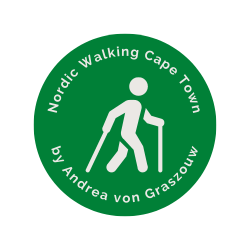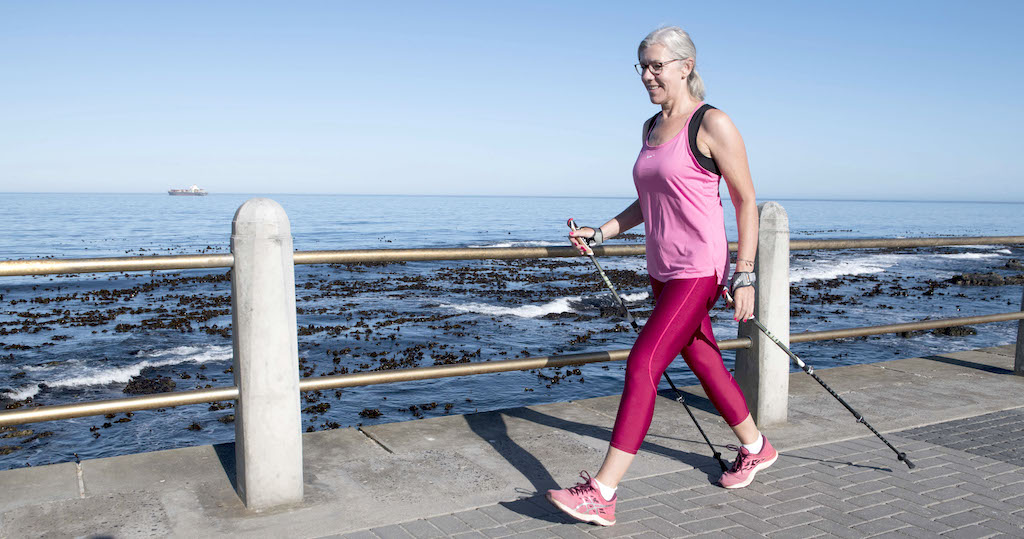In this FAQ Nordic walking I will answer the most common questions that I have been asked during my workouts over the past few weeks.
WHY NORDIC WALKING?
Walking comes naturally to us. It is the most common human activity. Our body allows us to maintain balance, placing our body in an upright posture while providing flexibility, mobility and stability. Nordic walking combines cardiovascular exercise with a vigorous muscle workout for your shoulders, arms, core and legs. “When you walk without poles, you activate muscles below the waist. When you add Nordic poles, you activate all of the muscles of the upper body as well,” Dr. Aaron Baggish explains. “You’re engaging 80% to 90% of your muscles, as opposed to 50%, providing a substantial calorie-burning benefit.” (Source 1)
HOW DID NORDIC WALKING DEVELOP?
The sport originated in Finland in the 1940s as summer training for cross-country skiers. Nordic walking first came to Germany in the 1980s. Due to newly developed Nordic walking poles, it has become a popular sport worldwide since the 1990s. The Finnish trainer Mauri Repo was the first to define Nordic walking as a sport.
WHY IS IT CALLED NORDIC WALKING AT ALL?
The term Nordic walking is an analogy to Nordic skiing. It seeks to recreate the health benefits of cross-country skiing.
WHAT IS THE MOST IMPORTANT ASPECT OF NORDIC WALKING FOR ANDREA HERSELF?
Besides the things I said at the beginning, I work a lot in front of the computer at my desk. This causes back pain and tension. To release it I practise Nordic walking. With Nordic walking, I have an upright posture and open up my upper body. I have also noticed that my abdominal and back muscles are strengthened through this sport. I feel healthier, fitter and happier overall.
WHY DID I RECOMMEND NORDIC WALKING TO MY PARENTS?
My father has had three operations on his spine so far. Doctors recommended him a stick to help him walk. But this puts a one-sided strain on his body, which is unhealthy and aggravates his problems.
WHICH NORDIC WALKING POLES DO I USE?

I chose the best Nordic walking poles, the Flash Carbon poles from the company Leki.
And this is why:
With these ultra-light Nordic walking poles made of carbon, daily walking becomes a comfortable thing! The walking poles in a fixed length are particularly light and are ideal for sporty exercise. The handle made of cork and plastic is comfortable to grip at all temperatures. The detachable Trigger S Shark 2.0 hand strap can be clipped into the handle of the pole and ensures excellent power transmission when walking. The breathable mesh fabric of the strap dries quickly and is very comfortable to wear. The “power grip” rubber attachments supplied can be used on hard surfaces to protect the Speed Tip against wear. The stylish, two-tone design of the Leki Flash Carbon are fancy and these Nordic walking poles are the first choice for the athletic and healthy way of Nordic walking.
Here you can find a short video about the Nordic walking poles I travel with.
WHAT IS THE BEST ENVIRONMENT TO USE NORDIC WALKING POLES IN?
The advantage is that you can use the Nordic walking poles I use in the lowlands and in the mountains. All you have to do to use them on non-tarmacked surfaces is remove the power grip. I prefer to use the Nordic walking poles on level roads and paths. The poles can even be a hindrance while hiking or climbing.
WHY IS NORDIC WALKING HEALTHY?
Nordic walking strengthens the entire body. The sweeping movements of Nordic walking put a strain on the heart and blood circulation. This stimulates the metabolism and gets rid of excess pounds.
WHAT IS BETTER, RUNNING OR NORDIC WALKING?
Of course, you can’t generalize because people are different. However there is one big advantage to Nordic walking: your joints, tendons and ligaments are put under significantly less stress, while your cardiovascular system performs similarly to running. Before you start exercising, it is best to consult your doctor.
IS NORDIC WALKING GOOD FOR MY BUTT?
Yes! The muscles in your thighs and buttocks are naturally engaged when you walk. If you walk a little faster to reach an average speed of 6 to 9 km/h, your muscles will contract even more intensively and will gradually become stronger.
WHO SHOULD AVOID NORDIC WALKING?
People with arthrosis or problems in the shoulder joints would not necessarily do themselves any good with Nordic walking. If you are unsure whether Nordic walking is the right sport for you, talk to your doctor first.
WHICH BRAND WOULD I RECOMMEND?
It’s Leki. I have never held better Nordic walking poles than these.
HOW CAN I FIND OUT THE RIGHT LENGTH OF MY NORDIC WALKING POLES?
The rule of thumb for the pole length calculation is: height x 0.66 = optimal length. For example, a woman who is 170 cm tall would have to multiply her height by 0.66 and choose a Nordic walking pole length of 112.2 cm. The best thing would be to get advice from a Nordic walking instructor.
WHERE CAN I BUY THE NORDIC WALKING POLES?
Unfortunately, I can’t make a specific recommendation for South Africa. If I were you, I would seek advice from a specialized shop or do an internet search.
WHAT ARE THE MOST COMMON MISTAKES IN NORDIC WALKING I HAVE SEEN?
The 5 most common mistakes I’ve seen in Nordic walking on the Sea Point Promenade:
1. The Nordic walking poles are not the right height.
2. The Nordic walking poles do not have a wrist strap (or the wrong one).
3. The Nordic walking poles do not have a power grip for asphalt.
4. The Nordic walking poles have the wrong (straight) power grip.
5. Incorrect technique when using the Nordic walking poles.
You can definitely do better! How? Read my first blog article here!


